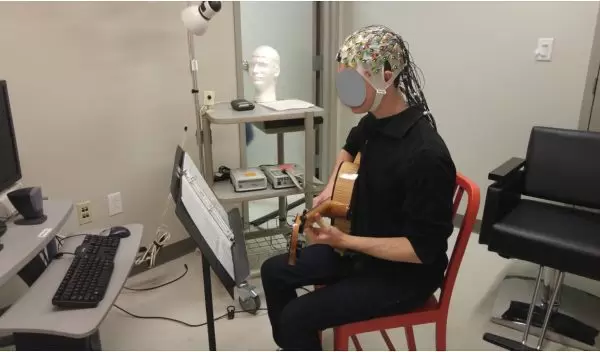
Where in the brain does creativity come from? Evidence from jazz musicians
According to a popular view, creativity is a product of the brain's right hemisphere -- innovative people are considered "right-brain thinkers" while "left-brain thinkers" are thought to be analytical and logical. Skeptical neuroscientists have argued that there is not enough evidence to support this idea and that an ability as complex as human creativity must draw on vast swaths of both hemispheres. A new brain-imaging study out of Drexel University's Creativity Research Lab sheds light on this controversy by studying the brain activity of jazz guitarists of varied experience during their improvisations.
The study, published in the journal NeuroImage and funded by a grant from the National Science Foundation, shows that creativity is, in fact, driven primarily by the right hemisphere in musicians who are comparatively inexperienced at improvisation. However, musicians who are highly experienced at improvisation rely primarily on their left hemisphere. This suggests that creativity is a "right-brain ability" when a person deals with an unfamiliar situation but that creativity draws on well-learned, left-hemisphere routines when a person is experienced at the task.
This research may contribute to the development of new methods for training people to be creative in their field. For instance, when a person is an expert, his or her performing is produced primarily by relatively unconscious, automatic processes that are difficult for a person to consciously alter, but easy to disrupt in the attempt, as when self-consciousness causes a person to "choke" or falter.
In contrast, novices' performances tend to be under deliberate, conscious control. Thus, they are better able to make adjustments according to instructions given by a teacher or coach. Releasing conscious control prematurely may cause the performer to lock-in bad habits or nonoptimal technique. Recordings of brain activity could reveal the point at which a performer is ready to release some conscious control and rely on unconscious, well-learned routines.
Using high-density electroencephalograms (EEGs), the team recorded electrical signals in the brains of 32 jazz guitar players as they improvised.
"If creativity is defined in terms of the quality of a product, such as a song, invention, poem or painting, then the left hemisphere plays a key role," said Drexel's John Kounios, who led the study along with David Rosen. "However, if creativity is understood as a person's ability to deal with novel, unfamiliar situations, as is the case for novice improvisers, then the right hemisphere plays the leading role."


